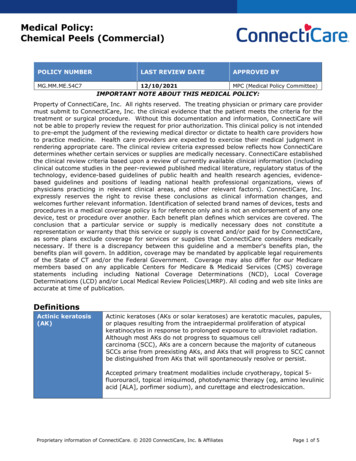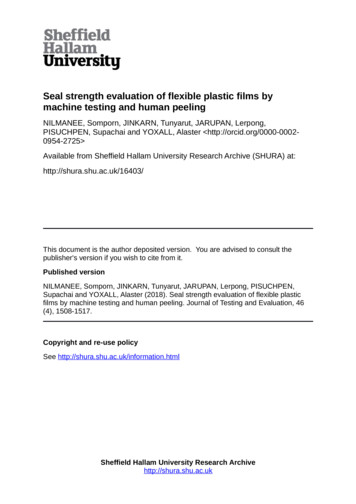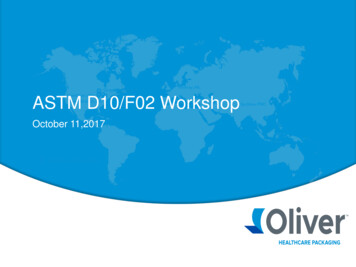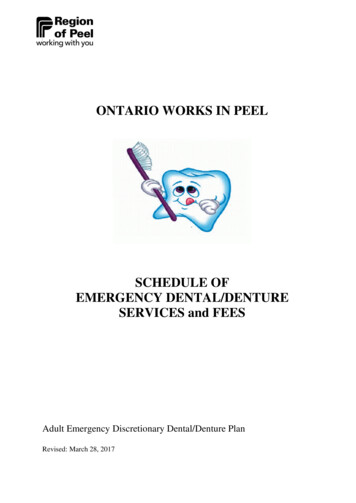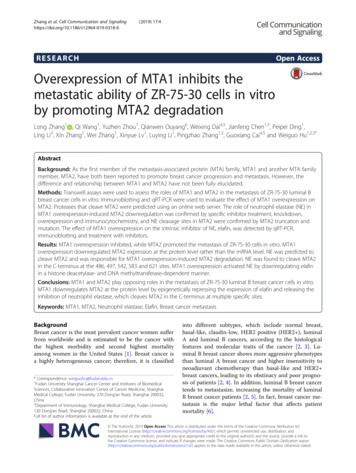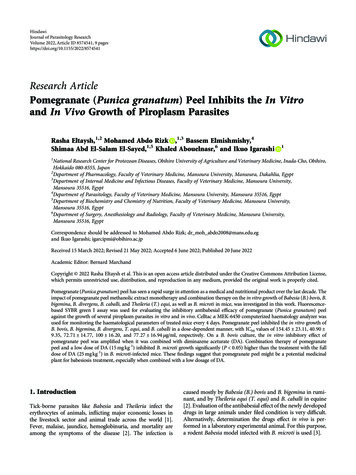
Transcription
nclusionsB. bigemina and B. divergens preceded by B. caballi were themost susceptible Babesia species to the in vitro inhibitoryaction of pomegranate peel. Pomegranate peel in combination with DA exhibited synergistic interaction against thein vitro growth of B. bovis. Mice treated with a combinationtherapy containing lower dosages of pomegranate peel andDA showed a considerable reduction in fluorescence levels.Furthermore, the pomegranate peel/DA combination therapy normalizes the haematological variables and treat hemolytic anemia associated with babesiosis. According to thefindings of this study, pomegranate peel may be effective inthe treatment of animal piroplasmosis, particularly whencombined with DA. Although this study evaluated the antibabesial efficacy of methanolic extract of pomegranate peelin vitro and in vivo, the study neglected the identificationof the medicinally active substances in the methanolicextract of pomegranate peel. Therefore, future studies arerequired to perform phytochemical analysis to the usedextract. Also, further studies are required to examine theability of pomegranate peel/DA to remove the nucleic acidof the parasite from different body tissues of the treated miceafter prolonged period of the experiment.Data AvailabilityOn reasonable request, the corresponding author will provide the datasets created and/or analyzed during the currentwork.Ethical ApprovalThe Animal Care and Use Committee at the Obihiro University of Agriculture and Veterinary Medicine approvedall of the study’s experimental protocols (approval no. 2765). The experiments were carried out following the Ministry of Education’s Culture, Sports, Science, and Technology,Japan Fundamental Guidelines for the Proper Conduct ofAnimal Experiments and Related Activities at AcademicResearch Institutions.Conflicts of InterestThe authors declare that they have no competing interests.
8Journal of Parasitology ResearchAuthors’ ContributionsMohamed Abdo Rizk and Ikuo Igarashi are responsible forconceptualization; Rasha Eltayesh and Mohamed Abdo Rizkfor data curation; Mohamed Abdo Rizk, Shimaa El-Sayed,Basem Elmishmishy, and Khaled Abouelnasr for formalanalysis; Ikuo Igarashi for funding acquisition; MohamedAbdo Rizk and Ikuo Igarashi for investigation; RashaEltayesh and Mohamed Abdo Rizk for methodology; IkuoIgarashi for project administration; Mohamed Abdo Rizkand Ikuo Igarashi for resources; Mohamed Abdo Rizk forsoftware; Ikuo Igarashi for supervision; Ikuo Igarashi for validation; Mohamed Abdo Rizk and Ikuo Igarashi for visualization; Mohamed Abdo Rizk and Basem Elmishmishy forwriting—original draft; and all authors for writing—reviewand editing.[3][4][5][6]AcknowledgmentsThe authors would like to greatly thank Prof. NaoakiYokoyama, National Research Center for Protozoan Diseases, Obihiro University of Agriculture and VeterinaryMedicine, Inada-cho, Obihiro, Hokkaido, Japan, for his scientific support and discussion. This study was supportedfinancially by the Ministry of Education, Culture, Sports,Science, and Technology of Japan. Mohamed Abdo Rizkwas supported by a research grant fellowship for young scientists from the Japan Society for the Promotion of Science(JSPS) (ID no. P18091).Supplementary Materials[7][8][9][10]Supplementary 1. Table S1: viability test results of diminazene aceturate drug evaluated for Babesia and Theileriaparasite.[11]Supplementary 2. Table S2: fluorescence values of the inhibitory effect of pomegranate (Punica granatum) peel monoand combination therapies on the growth of Babesia microtiin BALB/C mice.[12]Supplementary 3. Figure S1: PCR of the ss-rRNA gene inblood and different organs of B. microti-infected mice. A.Infected nontreated mice (positive control) and noninfectedand nontreated mice (negative control). B. Mice treated with25 mg kg-1 diminazene aceturate. C. Mice treated withpomegranate (Punica granatum) peel combined with diminazene aceturate. PC: positive control; NC: negative control;Bl: blood; Hr: heart; Lg: lung; Lv: liver; Kd: kidney; Sp:spleen. M indicates a 100 bp DNA ladder.References[1] J. Mosqueda, A. Olvera-Ramirez, G. Aguilar-Tipacamu, andG. J. Canto, “Current advances in detection and treatment ofbabesiosis,” Current Medicinal Chemistry, vol. 19, no. 10,pp. 1504–1518, 2012.[2] M. A. Rizk, S. A. E. El-Sayed, S. El-Khodery, N. Yokoyama, andI. Igarashi, “Discovering the in vitro potent inhibitors againstBabesia and Theileria parasites by repurposing the malaria[13][14][15][16]box: a review,” Veterinary Parasitology, vol. 274, article108895, 2019.M. A. Rizk, M. AbouLaila, S. A. E. El-Sayed, A. Guswanto,N. Yokoyama, and I. Igarashi, “Inhibitory effects of fluoroquinolone antibiotics on Babesia divergens and Babesiamicroti, blood parasites of veterinary and zoonotic importance,” Infection and Drug Resistance, vol. 11, pp. 1605–1615,2018.M. Yamasaki, N. Watanabe, N. Idaka et al., “Intracellulardiminazene aceturate content and adenosine incorporationin diminazene aceturate-resistant Babesia gibsoni isolatein vitro,” Experimental Parasitology, vol. 183, pp. 92–98, 2017.E. Shaygannia, M. Bahmani, B. Zamanzad, and M. RafieianKopaei, “A review study on Punica granatum L,” Evidencebased Complementary and Alternative Medicine, vol. 21,no. 3, 227 pages, 2016.S. R. Foss, C. V. Nakamura, T. Ueda-Nakamura, D. A. Cortez,E. H. Endo, and B. P. Dias Filho, “Antifungal activity of pomegranate peel extract and isolated c
4Department of Parasitology, Faculty of Veterinary Medicine, Mansoura University, Mansoura 35516, Egypt 5Department of Biochemistry and Chemistry of Nutrition, Faculty of Veterinary Medicine, Mansoura University, Mansoura 35516, Egypt 6Department of Surgery, Anesthesiology and Radiology, Faculty of Veterinary Medicine, Mansoura University .

